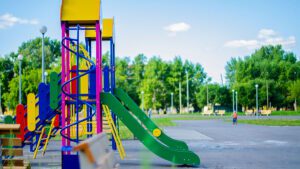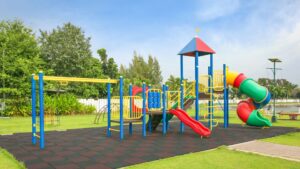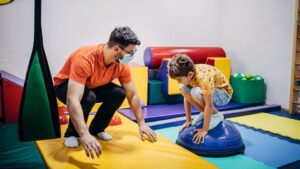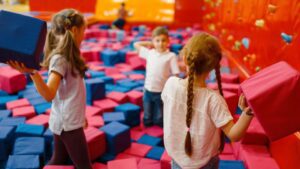Мягкие игры - один из самых популярных видов активного отдыха для детей младшего возраста, и не зря. Они безопасны, насыщены сенсорными ощущениями и призваны поддерживать физическое, когнитивное и социальное развитие. Если вы родитель, решающий, куда отвести детей, заведующая детским садом, планирующая планировку, или оператор торгового центра, оценивающий аттракционы, это руководство объяснит, что такое мягкие игры, как они полезны для детей, где их можно установить и что нужно учитывать при выборе оборудования.

Краткое определение: Что такое мягкая игра?
Мягкая игра относится к крытым игровым зонам, построенным из мягких, амортизирующих и безопасных для детей компонентов. Как правило, это пеноблоки, ямы для мячей, мягкие конструкции для лазания, низкие горки, туннели и сенсорные панели. Все элементы мягкой игровой среды отделаны мягким винилом или тканью, прошиты машинным способом для долговечности и предназначены для минимизации травм во время активных игр.
Мягкие игры воспроизводят приключенческие аспекты открытых игровых площадок, но адаптируют их для безопасности в помещении, небольших пространств и младших возрастных групп. Они идеально подходят для малышей и дошкольников, но в современных конструкциях часто предусмотрены зоны и для детей постарше.

Виды мягкого игрового оборудования
Мягкие игры бывают разных форм и размеров. Знание возможностей поможет вам выбрать оборудование, соответствующее вашему пространству, бюджету и целевой возрастной группе.
- Шаровые ямы - классические сенсорные зоны, наполненные пластиковыми шариками; отлично подходят для тактильных игр.
- Мягкие блоки и модульные наборы - Пенопластовые фигуры, которые дети складывают, переползают и строят из них.
- Мини-горки и пандусы - Пологие склоны для малышей, чтобы они могли потренироваться в лазании и скольжении.
- Ползучие туннели и низкие лабиринты - Способствуют исследованию и осознанию пространства.
- Мягкие скульптурные животные и фигуры - тематические фигурки (динозавры, машины, деревья), которые развивают воображение.
- Сенсорные панели и стены для занятий - сенсорные, звуковые и визуальные стимулы для развития мелкой моторики.
- Многоуровневые мягкие игровые конструкции - небольшие башни и платформы с мягкими барьерами для дошкольников.
- Интегрированные зоны для ролевых игр - рыночные прилавки, кухни и дома из мягких материалов.
- Интерактивный мягкий пол - мягкие поверхности с напечатанными дорожками или играми для организованных занятий.

Преимущества мягких игр для детей
Мягкие игры - это не просто развлечение, это инструмент развития. Вот как они помогают детям расти.
1. Физическое развитие (грубая и мелкая моторика)
Лазание, ползание, прыжки и балансирование в мягкой игре укрепляют крупные группы мышц. Более мелкие манипулятивные задачи - нажатие на панель, поворот ручки - развивают мелкую моторику и зрительно-моторную координацию.
2. Сенсорная стимуляция
Мягкая игровая среда обеспечивает мультисенсорный ввод (осязание, зрение, звук, проприоцепция). Это способствует сенсорной интеграции, успокаивает перевозбужденных детей, помогает младенцам и детям ясельного возраста регулировать сон и настроение.
3. Когнитивные навыки и навыки решения проблем
Выбор маршрута в мягком лабиринте, складывание блоков в башню или переговоры о поворотах требуют планирования, последовательности действий и решения базовых проблем - раннее обучение исполнительным функциям, замаскированное под игру.
4. Эмоциональная устойчивость и уверенность
Освоение небольшого подъема или нового препятствия укрепляет уверенность в себе. Мягкая игровая среда с низким уровнем риска побуждает детей повторить попытку после неудачи, что способствует развитию упорства и самооценки.
5. Социальные навыки и язык
Общие пространства способствуют взаимодействию: дети учатся договариваться, делиться, действовать по очереди и строить дружеские отношения. Зоны ролевых игр развивают словарный запас и умение рассказывать истории.
Где можно установить мягкий игровой комплекс?
Мягкие игры отличаются гибкостью и могут быть адаптированы к разным местам:
- Детские сады, дошкольные учреждения и центры дневного ухода - ежедневные игры, ориентированные на развитие.
- Крытые игровые центры и семейные развлекательные заведения - аттракционы, приносящие доход.
- Торговые центры, кафе и моллы - семейный розыгрыш, который увеличивает время пребывания.
- Центры досуга и общественные залы - структурированные занятия или открытые игровые сессии.
- Больницы и терапевтические центры - сенсорные зоны для поддержки развития и восстановления.
- Частные дома и усадьбы - небольшие установки на заказ для игровых комнат.
- Рестораны и отели - семейные удобства, которые повышают ценность для родителей.

Советы по проектированию: создайте великолепную мягкую игровую зону
Хорошо спроектированная мягкая игровая зона обеспечивает баланс между развлечениями, безопасностью и эксплуатационными потребностями.
- Зонирование по возрасту: Отделите зоны для малышей и малышек от зон дошкольного или смешанного возраста.
- Четкие линии обзора: Родители и персонал должны легко наблюдать за детьми - избегайте визуальных барьеров.
- Прочная безопасная поверхность: Используйте мягкие полы, которые легко чистить и которые устойчивы к скольжению.
- Материалы, не требующие особого ухода: Выбирайте виниловые чехлы с усиленной строчкой и сертификатом огнестойкости.
- Доступный дизайн: По возможности сделайте дорожки достаточно широкими для колясок и инвалидных кресел.
- Оформление и цвет: Яркие, дружелюбные палитры и тематические предметы (джунгли, океан, ферма) повышают вовлеченность.
- Складские помещения и помещения для персонала: Предусмотрите место для персонала, средств первой помощи, чистящих средств и аккуратного хранения.
- Планирование гигиены: Конструкция со съемными, протираемыми крышками позволяет часто проводить уборку.

Стандарты и правила безопасности
Соблюдение стандартов не подлежит обсуждению. Операторы мягких игр должны следовать местным стандартам безопасности (например, ASTM, EN 1176/1177 в Европе и соответствующим национальным нормам). Ключевые методы обеспечения безопасности:
- Покупайте оборудование, проверенное на соответствие промышленным стандартам.
- Выполните установку в соответствии с рекомендациями производителя и проведите профессиональную экспертизу.
- Составьте контрольный список для регулярного осмотра и обслуживания.
- Обучите персонал наблюдению, протоколам действий в чрезвычайных ситуациях и процедурам уборки.
- Разместите четкие правила для возрастных групп и ограничения по вместимости.

Уборка и обслуживание
Мягкие игровые комплексы интенсивно используются, поэтому их чистка имеет решающее значение для безопасности и репутации.
- Ежедневная уборка: Протрите поверхности, к которым прикасаются, пропылесосьте/просушите полы, очистите ямы для мячей от мусора.
- Еженедельная глубокая чистка: Вымойте мячи в яме, очистите паром тканевые панели, если это возможно, продезинфицируйте сенсорные панели.
- Регулярные проверки: Проверяйте швы, крепления, целостность пенопластовой сердцевины и своевременно заменяйте изношенные детали.
- Журнал технического обслуживания: Отслеживать ремонты, инциденты и графики уборки для проведения аудита на соответствие требованиям и страхования.
Выбор поставщика или производителя
Выбирая поставщика мягких игр, обратите внимание на:
- Сертификаты безопасности и характеристики материалов (огнестойкость, винил без фталатов).
- Возможность индивидуального проектирования (тематика, индивидуальные размеры, проектирование с учетом специфики объекта).
- Гарантия и запасные части политика.
- Рекомендации и портфолио игровых площадок - попросите показать действующие установки.
- Послепродажное обслуживание - установка, обучение персонала и техническая поддержка.
- Практика устойчивого развития - Материалы, подлежащие вторичной переработке, и пенопласт/винил этического происхождения.
Запросите 3-4 предложения и сравните не только цену, но и условия гарантии, время выполнения заказа и включенные услуги (установка, обучение на месте, руководства).
Коммерческие соображения: Окупаемость инвестиций и идеи программирования
Для предприятий мягкие игры - это не просто развлечение, а источник дохода при правильном подходе.
- Допуск к открытой игре (сеансы с таймером) обеспечивает постоянный приток посетителей.
- Частный прокат и дни рождения являются высокодоходными.
- Занятия и семинары (сенсорная гимнастика для детей, гимнастика для малышей, йога для родителей и малышей) увеличивают наполняемость в будние дни.
- Членство и лояльность поощрять повторные посещения.
- Перекрестные продажи продуктов питания и розничной торговли: кафе, магазины подарков и дополнительные услуги для вечеринок увеличивают расходы на посещение.
- Корпоративный или школьный найм расширять потоки доходов B2B.
Часто задаваемые вопросы (кратко)
В: Для каких возрастов используются мягкие игры?
О: В основном от 0 до 6 лет для классических мягких игр; дети постарше могут использовать более крупные мягкие конструкции для лазания, когда зоны разделены.
В: Гигиеничны ли мягкие игровые зоны?
О: Да - при ежедневной уборке и использовании рекомендованных производителем дезинфицирующих средств мягкие игры могут быть гигиеничными и безопасными.
В: Как долго служит оборудование?
О: Качественные мягкие игры при правильном уходе могут прослужить 7-15+ лет. Виниловые покрытия и поролон могут нуждаться в периодической замене.
В: Можно ли устанавливать мягкие игры на открытом воздухе?
О: Некоторые модульные изделия устойчивы к погодным условиям, но большинство мягких игр предназначено для использования внутри помещений. Для использования на открытом воздухе необходимы материалы, устойчивые к ультрафиолетовому излучению, и дренажные системы.
Заключение
Мягкие игры - это мощное сочетание безопасности, сенсорной стимуляции и увлекательного воображения. Они способствуют раннему развитию в физической, когнитивной, эмоциональной и социальной сферах, предлагая при этом гибкие варианты установки для детских садов, торговых и развлекательных центров. Проектируете ли вы зону для малышей, выбираете ли оборудование для детского сада или планируете игровой центр, приносящий доход, приоритетами должны быть безопасность, четкие линии обзора, простота обслуживания и зонирование по возрасту. При правильном проектировании и программировании мягкие игры становятся бесценным пространством, где дети учатся, исследуют и процветают.




